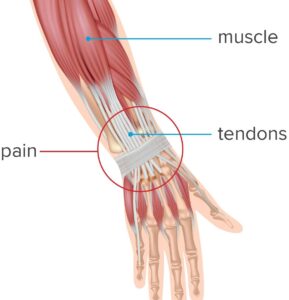If you have a dull, nagging pain in your wrist, it might be wrist tendonitis. Learn about its symptoms, causes, treatment options, and home remedies.
What is Wrist Tendonitis?
Wrist tendonitis occurs when a tendon in the wrist becomes inflamed. It causes pain, swelling, and weakness in the wrist. Tendons are fibrous connective tissues that keep your muscles connected to the bones.
Overuse injuries are the major causes of wrist tendonitis in young athletes. Besides, deposition of calcium in the tendons may cause a condition called acute calcific tendonitis (ACT). However, ACT rarely affects the wrist.1https://www.ncbi.nlm.nih.gov/pmc/articles/PMC6261391/
Related: What is a Sprained Wrist?
Symptoms of Wrist Tendonitis
 When you have wrist tendonitis, the inflamed tendon rubs against the bone. Pain and stiffness – more common in the morning – are the two main symptoms of wrist tendonitis. The pain is usually dull and tends to worsen with the movement of the wrist.
When you have wrist tendonitis, the inflamed tendon rubs against the bone. Pain and stiffness – more common in the morning – are the two main symptoms of wrist tendonitis. The pain is usually dull and tends to worsen with the movement of the wrist.
Other symptoms may include:
- Warmth and redness in the affected wrist
- Swelling and inflammation, which may be visible
- Reduced wrist mobility (may make it harder for you to type or text)
- “Creaking” noise when you move your wrist
- Weakness in the wrist
Besides, you may have problems gripping, pinching, or using a computer mouse.
With proper treatment, most symptoms go away within 2 to 3 weeks. Nonetheless, some may persist longer and require specific treatment, including surgery.
When to See a Doctor?
Call your doctor if:
- Your condition does not improve within 2 to 3 weeks.
- You have severe pain (it could be due to other medical conditions or more severe injury)
- You have marked weakness or cannot move the affected wrist (may indicate a tendon rupture)
What Causes Wrist Tendonitis?
Injuries resulting from overuse or repetitive movement are the major causes of wrist tendonitis. Common activities requiring such movements include:
- Typing and using a computer mouse
- Playing video games
- Texting
- Writing
- Sports activities that involve wrist mobility
- Performing tasks, such as hammering or chopping wood
Other causes or contributing factors may include:
- Age
- Bad wrist posture
- Poorly aligned joints
- An acute injury resulting from impact
- Diabetes
Treatment Options
Several treatment options (surgical and non-surgical) are available for wrist tendonitis. Your doctor will recommend an appropriate type of treatment after assessing the cause and severity of your condition.
Ask your doctor if the following options are suitable for your condition:
- Stretching exercises, such as hand flips, wrist flexor stretch, and wrist radial and ulnar deviation
- Bracing or splinting the wrist to support inflamed tendon
- Non-steroidal anti-inflammatory drugs (NSAIDs) to control pain and swelling (both OTC and prescription products are available)
- Injecting a steroid into the affected wrist to control inflammation
- Occupational therapy to help you perform activities that require wrist movement
Surgery for Wrist Tendonitis
Surgery for wrist tendonitis may be an option if the treatments mentioned above fail or you have a damaged tendon. That said, surgery is not always beneficial, and the type of injury determines whether you are a candidate for surgery.
Home Remedies for Wrist Tendonitis
Most people with minor cases of wrist tendonitis can expect recovery with the following tips:
- P.R.I.C.E. Protection, Rest, Ice, Compression, and Elevation are highly effective in treating acute inflammation. Rest is critical to preventing complications and supporting recovery. If you return to sports activities too early, your condition may progress to chronic tendonitis. Unlike acute tendonitis, chronic cases are hard to treat.
- Avoidance. Make sure not to engage in repetitive activities that might worsen your symptoms or lead to adverse consequences.
- Medications. Consider taking an OTC pain reliever to help reduce inflammation and pain. These medications work by blocking specific chemicals that your body uses to make inflammatory substances.
- Nutrition. The deficiency of vitamin C, manganese, vitamin B6, vitamin E, and zinc can impair collagen production and tendon health. Ask your doctor if supplementation can aid recovery.
Also Read: Diet and Nutrition Considerations for Treating Tendinitis
https://twitter.com/Foervraengd/status/1226466920595062785?s=20
Is It Possible to Prevent Wrist Tendonitis? The Do’s and Don’ts
Repetitive exercise is the leading cause of wrist tendonitis. Thus, it is best to avoid or limit such activities.
Do’s
- Always warm-up before you exercise or engage in strenuous activity
- Gently stretch after you finish exercising
- Take regular breaks when doing repetitive exercises (a 5-min break every 30 minutes)
- Wear braces when doing a repetitive task
- Perform doctor-recommended wrist exercises
Don’ts
- Do not overuse your wrist
- Avoid starting a new sport without proper training
Further Reading: How to prevent burnout, overuse in youth athletes?
FAQ’s
- How long does it take to heal wrist tendonitis?
Wrist tendonitis typically improves within 2 to 3 weeks with home remedies and non-surgical treatments. However, chronic tendonitis is hard to treat and needs specialized therapies.
- Does wrist tendonitis heal on its own?
Most cases heal with P.R.I.C.E. (Protection, Rest, Ice, Compression, and Elevation), pain medications, and avoidance of repetitive tasks. But symptoms of wrist tendonitis may mimic those of other severe conditions, such as arthritis or infection. Thus, it is wise to seek medical help if your symptoms do not go away within 2 weeks of self-care.
Get a Telehealth Appointment or Second Opinion With a World-Renowned Orthopedic Doctor
 Telehealth appointments or Second Opinions with a top orthopedic doctor is a way to learn about what’s causing your pain and getting a treatment plan. SportsMD’s Telehealth and Second Opinion Service gives you the same level of orthopedic care provided to top professional athletes! All from the comfort of your home.. Learn more via SportsMD’s Telemedicine and Second Opinion Service.
Telehealth appointments or Second Opinions with a top orthopedic doctor is a way to learn about what’s causing your pain and getting a treatment plan. SportsMD’s Telehealth and Second Opinion Service gives you the same level of orthopedic care provided to top professional athletes! All from the comfort of your home.. Learn more via SportsMD’s Telemedicine and Second Opinion Service.
References
- Shim, Man R. “Unusual Etiology of Acute Wrist Pain: Acute Calcific Tendonitis of the Flexor Carpi Ulnaris Mimicking an Infection.” Case reports in orthopedics vol. 2018 2520548. 14 Nov. 2018, doi:10.1155/2018/2520548.
